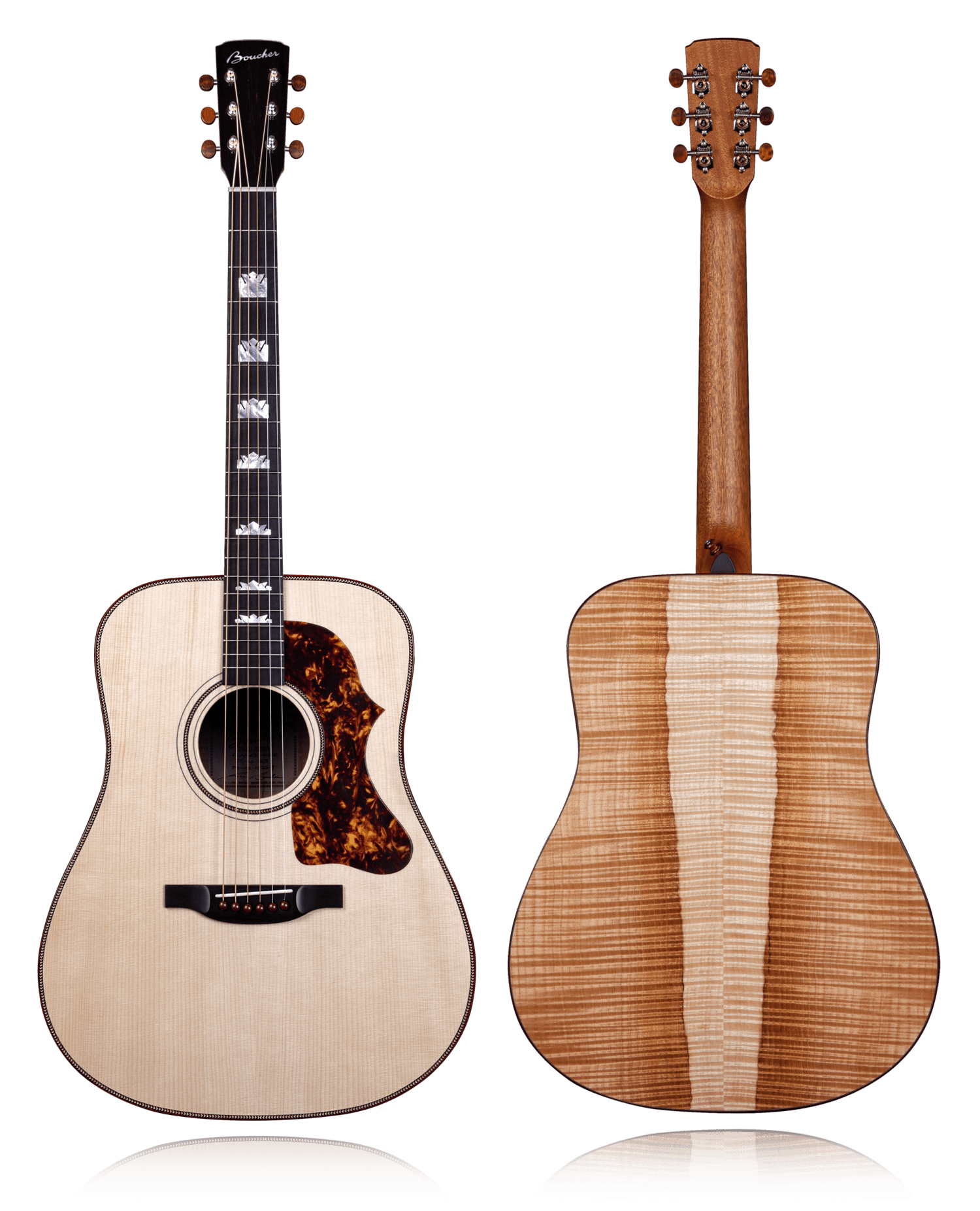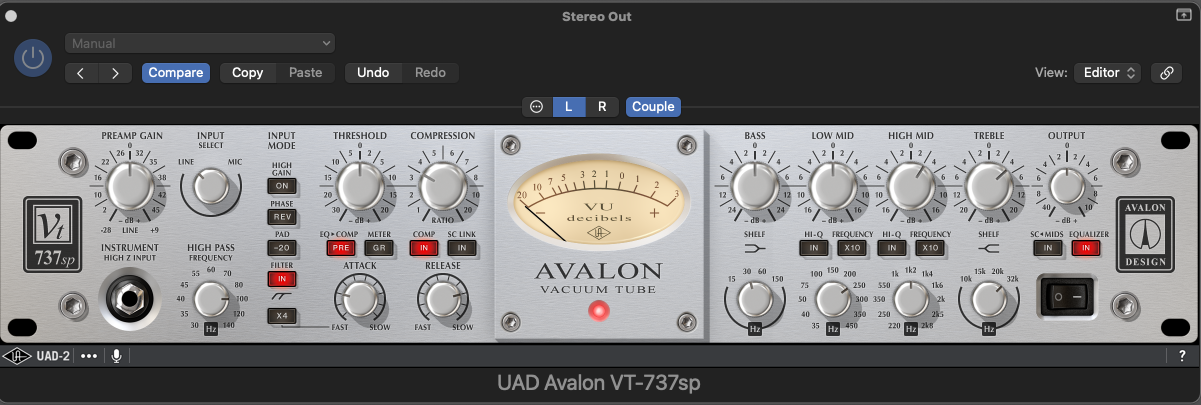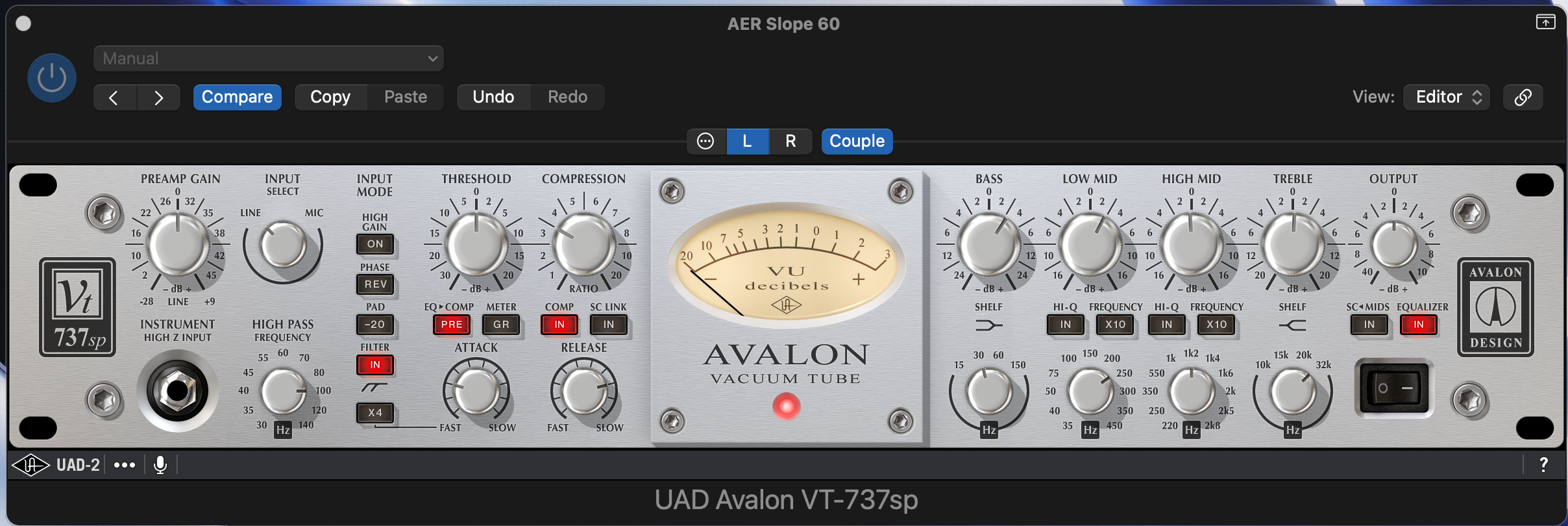Maple Back and Sides for Your Acoustic Guitar
Boucher PS-SG-612 Sample Photo. Photos copyright Boucher Guitars
Hey readers. I wanted to take a bit of time to explore an uncommon choice of wood for the sides and back of your acoustic guitar.
In fairness, maple sides and backs for acoustic guitars is not an unknown thing. Gibson has done it for years in their J-200 and J-100 models and Epiphone does it in their Inspired by Gibson Jumbo acoustics. Taylor also used maple in their jumbo models, but it disappeared for a bit and is now back in their Model 618 jumbo.
Do you see the one element of commonality? When we find maple, it’s usually in a Jumbo style model. Except it does not have to be. Violins have been made of maple for centuries, so why is it not more common in guitars?
Tonewood Characteristics
We can have bun fights all day long over whether the wood in a solid body guitar matters (it actually does according to acoustic science) but we all know and accept that the wood in an acoustic guitar matters. Mahogany or Rosewood back and sides are the most common woods with spruce variants and to a lesser extend cedar for the tops.
Maple as a tone wood is known for a very linear tone. It is respected for an extended bass range while not losing crispness in the high end. Maple has a relatively fast decay, which folks associate with limited sustain. This is factually incorrect however as fast decay does not imply limited sustain. In reality maple has excellent sustain and delivers a pleasing complexity because it does not bias in a particular tonal range. Maple is known to evoke a warmer tone than some other woods as well, which makes it a great wood for singer songwriters who sing in the tenor and alto ranges. A good example of maple sides and back providing excellent support to this type of vocalist would be Emmylou Harris who is widely known for her regular use of the Gibson J-200 guitar.
Maple also has a rapid response curve which makes it equally ideal in the studio as on the stage.
Maple comes in two primary variants, soft maple and hard maple. Soft maple is not really soft, it has similar hardness to Black Walnut. When you pick up a guitar brochure, and see Red Maple, Silver Maple, Bigleaf Maple or Striped Maple, you are seeing a maple that falls into the soft maple bucket. There is nothing wrong with the use of soft maple. It tends to be a bit less bright as it is not quite as stiff, and has a greater dampening effect. Maples such as Hard Maple, Black Maple and Florida Maple fall into the hard maple category. These woods only grow on the east coast of North America. These maples are stiffer, and therefore brighter and that stiffness means that they have a lower dampening effect than one of the soft maples.
We also encounter maples with a descriptor that can describe the look of the finished surface. For example, we read of Quilted Maple. It is not a species, simply a natural deformity found in soft maple woods. The distinctive looking wood called Spalted Maple is a soft or hard maple that developed a fungus causing rot. The rot stops when the maple is cut. Spalted maple is most commonly used as a cap on electric guitars or as a veneer. The rot impacts its acoustic consistency. Curly maple is another natural deformity that is found when the curl pattern is perpendicular to the grain. It has a wave like look to it. While Curly Maple can come from soft or hard varieties of maple, it is only revealed fully when the maple is cut in a particular way. Curly Maple is often referred to as Flame Maple.
A Boucher PS-SG-612 showing it’s Curly Maple back and sides. Each wood set is different
However, how the maple is cut can make a much more significant difference when used as a tonewood. When we cut a log, flat sawn is the most common method used, also known as slab sawn. It is done because it tends to reveal the grain more readily, producing slabs that we would call figured. Slab sawn wood is still maple, but his type of cutting reduces stiffness and thus brightness. The other sawing method is called quarter sawing. Quarter sawn wood maintains the stiffness but may display less figuring except in the case of Curly Maple, where quarter sawn examples really reveal the curl. Unless the maker specifies Curly Maple, which costs more, your figured example is likely slab sawn. You can tell by looking at the end grain of a slab, if the growth rings are parallel to the wide sides of the board it is slab sawn. If the growth rings are perpendicular to the wide sides of the board it is quarter sawn. Quarter sawn wood will not twist or warp but is much more difficult to cut and more expensive than slab sawn.
The Importance of Stiffness
Many advanced luthiers will use laminated woods for sides and backs because they want stiffness. We want the tops of acoustic guitars to move, but we don’t want the sides and backs to move. Unfortunately most brand name guitars with laminated sides and backs use thin pieces of tonewood with a cheap wood or even not wood in the centre of the sandwich. You cannot see it, but you can hear, or more correctly not hear the difference between a high end laminated sides and back and a cheap one with a tap test. The better laminate has better resonance. However a guitar with solid sides and back will have the most resonance and ring to it. To get the stiffness of a fine laminate, the better makers will use quarter sawn wood for the sides and back and this particularly applies when maple is used because we want the stiffness and resistance to warping and twisting that we find in quarter sawn wood. And pardon me for being obvious, a maple soundboard / top on an acoustic guitar is not a great plan.
A Superlative Example
As regular readers know, my favourite acoustic guitars come from Boucher Guitars that are made in Canada’s Quebec province in a town called Berthier Sur Mer. Boucher uses only top line woods, and is unique in that they use Adirondack Spruce instead of Sitka Spruce for their tops. While the two woods are nearly identical mechanically, the grain is typically wider in Adirondack Spruce, also known as Red Spruce than in Sitka Spruce or Engelmann Spruce which grow on the west coast of North America. Red Spruce can have more flex and rebound than Sitka or Engelmann Spruce. Martin used Red Spruce exclusively when they started up, but switched to Sitka because it is more widely available and is commonly less expensive. Be clear though that any quarter sawn spruce is going to be a pricey piece of wood.
I recently had opportunity to play a unique to me guitar from Boucher. It is a dreadnought sized body with Curly Maple sides and back and Red (Adirondack) Spruce top. I have never seen a maple dreadnought before and was not sure what to expect. When my friend Ryan of The Arts Music Store took it down and strummed it, it nearly knocked me down, it was so beautiful sounding with great low end that was not boomy and a crisp high end. It had incredible sustain and being one of Boucher’s Special Edition instruments the fit, the finish and the accoutrements were both superb and beautiful. This model is called the PS-SG-162. It is built to the body specifications of Boucher’s Studio Goose line. I already own a Boucher dreadnought in Adirondack over Rosewood that sounds amazing, yet this guitar of the same size, sounds very different indeed. It is a very good thing that I cannot afford it as I write this, or I would have to be making more space for it.
An example of the Boucher PS work
I went back and took a field recorder with me to do some quick sample recordings using a Zoom H4n. I did not want to get in the way of other customers so I limited my time with the guitar and did nothing special in the recording. I was again blown away by the powerful sound of this guitar, this time being the player and hearing it differently from when I was standing four or five feet from the sound hole. Despite this being a lower end recorder and that I was using the XY factory mics, I arranged with the store to evaluate the guitar in my studio for a couple of days. The sound in that room was stupendous and recordings using a matched pair of RODE NT-5 mics on an XY stand.
Dreadnoughts and Jumbos
I was very curious as to what my experience would be comparing a maple side and back Jumbo (my own Taylor 615ce) to the Boucher PS-SG-162 dreadnought.
Sample Sounds
These sample clips were recorded using a matched pair of RODE NT-5 microphones into separate channels on a Clarett+ 8Pre and from there into Logic Pro. I used my favourite preamp in Logic applied in post processing, so the actual recordings were solely the mic outputs. I recorded both the Boucher PS-SG-612 and my Taylor 615ce using the same mic setup and the same Avalon VT-737sp preamp in Logic. The graphic below shows that I used identical settings for both instruments.
In the next pair of samples, I used an Aston Origin microphone plugged directly into my AER Slope 60 with the tone controls at noon, and took the DI output from the AER direct to the Clarett+ 8Pre. I then recorded two separate samples, first with the Boucher PS-SG-612 and then with the Taylor 615ce.
In post processing I applied the same Avalon VT-737sp preamp, however, I did have to use different settings on the preamp as I lost some low end with the Taylor in this manner. The image of the Avalon is shown above each sample track.
Wrapping It Up
The two guitars sound different. This should be expected. The Boucher was made in 2023 and the Taylor back in the mid-2000s. Their body size, the bracing, the strings and other factors are different. You may like one better than the other, I like them both because they produce different results. Just for yucks I played my Gibson SJ-200 which is Sitka over Rosewood and it sounds completely different from both. Wood makes a difference. My friend Shane just got a brand new Taylor 618 which like the Boucher has no cutaway and it also has a richer bass than my older 615ce which is a cutaway.
The big deal here, which makes the point of the article is that maple sides and back using high end curly maple that is quarter sawn for solid sides and back produces a different sound from either mahogany or rosewood. Maple is plentiful and while quarter sawn maple is expensive, it does not cost as much as Madagascar Rosewood, and about the same as Honduran Mahogany for good pieces.
Note that mahogany is getting harder to find and you will fine Sapele offered as an equivalent. Sapele is related to Mahogany but is not a true Mahogany from a wood specialists criteria. In that space there are only three; Honduran Mahogany, Cuban Mahogany and Mexican Mahogany. African Mahogany is considered closer to true mahogany than Sapele, but not a true mahogany.
Given the ecological impact of diminishing true mahoganies and true rosewoods, one might be inclined to spend more time looking at an acoustic guitar with maple sides and back. Unless you are having a luthier do a custom build for you, I will always recommend solid wood sides and backs for the best tonal response, because you just don’t know for sure, how much of the wood you expect is actually in the laminate. Taylor Guitars build with maple sides and back in their 600 family but the body styles are limited. Gibson and Epiphone both have their J-200 variants. The Gibson is very expensive and my personal experience is that quality from instrument to instrument varies, while the Epiphone is under $1500 CAD and uses solid maple sides and back and quarter sawn Sitka spruce for the top. It sounds great, but some people dislike the use of Laurel for the fingerboard instead of rosewood. From a playability perspective, there is no real difference and if it really bugs you, a can of Monty’s Guitars Montepresso and some rubbing will get you to the rosewood look in short order.
However, and it pains me to accept that I cannot buy it, the Boucher PS-SG-612 is the best maple back and sides acoustic that I have ever heard or played. If one could afford it, that is the maple back and sides instrument to go for.
Thanks as always for reading. A big thanks to the Arts Music Store for allowing me to evaluate the Boucher for a day in my studio. Please post a comment or send in a question, I read and response to all of them. Until next time, peace.






